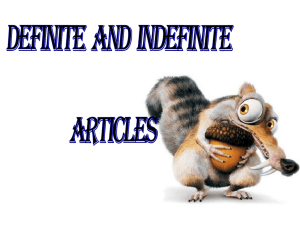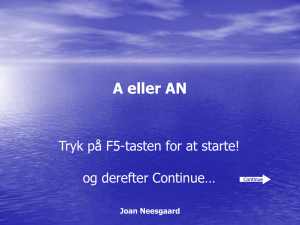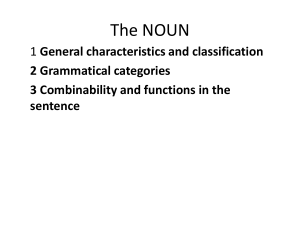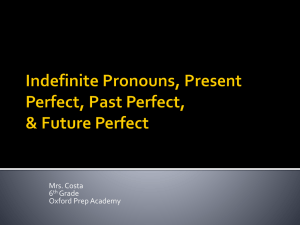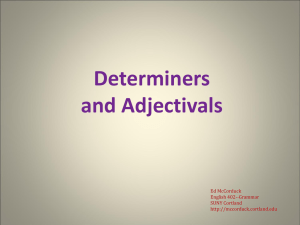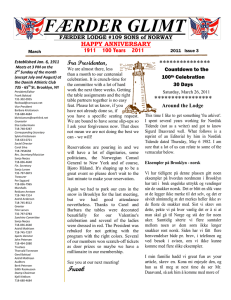DEFINITE AND INDEFINITE FORM
advertisement
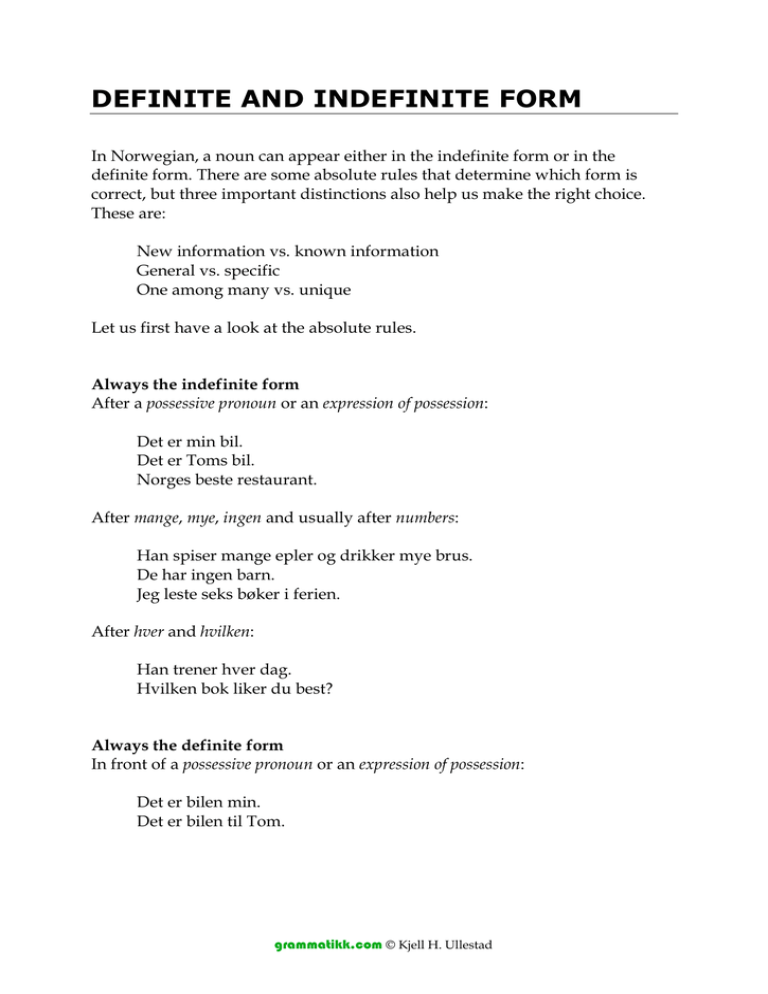
DEFINITE AND INDEFINITE FORM In Norwegian, a noun can appear either in the indefinite form or in the definite form. There are some absolute rules that determine which form is correct, but three important distinctions also help us make the right choice. These are: New information vs. known information General vs. specific One among many vs. unique Let us first have a look at the absolute rules. Always the indefinite form After a possessive pronoun or an expression of possession: Det er min bil. Det er Toms bil. Norges beste restaurant. After mange, mye, ingen and usually after numbers: Han spiser mange epler og drikker mye brus. De har ingen barn. Jeg leste seks bøker i ferien. After hver and hvilken: Han trener hver dag. Hvilken bok liker du best? Always the definite form In front of a possessive pronoun or an expression of possession: Det er bilen min. Det er bilen til Tom. grammatikk.com © Kjell H. Ullestad Definite and indefinite form | 2 After den/denne, det/dette and de/disse: Jeg vil ha den jakken. Disse skoene er fine. After mange av, mye av, ingen av and numbers + av: Han spiste mange av eplene og drakk mye av brusen. Ingen av barna var der. Jeg har lest to av bøkene. New information vs. known information We use the indefinite form when we introduce new information. Then, we use the definite form when we refer to this information. An example: Tom har en bil. Bilen er dyr. Han liker å kjøre bilen. Jakob har også en bil. Den er også dyr. Bilene er dyre. First we introduce a car (en bil) into the story. The definite form (bilen) tells the reader that we are not talking about any car, but Tom's car. The reader knows which car we are referring to. Therefore, we use the definite form. Then we introduce Jakob's car. This is new information. The reader has no previous knowledge of Jacob's car. Therefore, we use the indefinite form. Now, the reader knows about both Tom's car and Jakob's car. Therefore, we use the definite form in Bilene koster mye. The reader then understands that we are now talking about Tom's and Jakob's cars, not about cars in general. We usually use the indefinite form after "Det er..." because this structure introduces new information: Det er en mann der borte. Mannen heter... Er det en hund eller en katt? Jeg tror at det er en hund. "Det er..." does not always introduce a new noun, but sometimes an adjective may give new information about the noun. In that case, we must use the indefinite form even if the noun itself is not new information: Tom har en bil. Det er en fin bil. grammatikk.com © Kjell H. Ullestad Definite and indefinite form | 3 General vs. specific The definite form refers to something specific, while the indefinite form refers to something in general: Katter liker ikke hunder. Kattene liker ikke hunder. Kattene liker ikke hundene. (general: all cats and all dogs) (specific cats – all dogs in general) (specific cats and specific dogs) An important question when deciding which form of the noun to use, is: "Does the reader know which car/book/chocolate... I am talking about?" We use the definite form if the answer to this question is "yes". In the example with Tom's car, we introduce the car explicitly in the beginning of the story. Therefore, the reader knows what car we are talking about. However, sometimes the reader must rely on information from the context. An example: Imagine that it is your birthday, and a friend gives you two chocolates. One of them has nuts in it, the other does not. The next day, you meet your friend and say: Takk for sjokoladene. Jeg liker vanligvis ikke sjokolade, men jeg likte sjokoladen med nøtter. The definite form sjokoladene tells the friend that you are talking about some specific chocolates: the chocolates he gave you yesterday. Your friend knows this from the context, and the definite form implies: "You know which chocolates I mean." The indefinite form in Jeg liker vanligvis ikke sjokolade implies: "I am talking about all sorts of chocolate in general." Your friend then understands that you are not talking about the chocolates that you got from him. Then, you refer to a specific chocolate: the chocolate with nuts in it. Therefore, you use the definite form. A geographical specification often indicates that we are talking about a specific specimen of something. Therefore, we usually use the definite form together with a geographical specification: Gatene i Paris er pene. Barna på skolen er flinke. Koppene på bordet er hvite. (specific streets: in Paris) (specific children: at school) (specific cups: on the table) One among many vs. unique We use the definite form when we talk about something unique: grammatikk.com © Kjell H. Ullestad Definite and indefinite form | 4 Sola er varm. Jeg har vondt i ryggen. Hvordan er været i Oslo? (We only have one sun.) (I only have one back.) ("Weather" is a unique phenomenon.) An adjective can give new information about a "unique" noun. In that case, we must use the indefinite form if the adjective is in front of the noun: Han har en sterk rygg. The definite form often means "there is just one of this", whereas the indefinite form often means "one among many": Oslo er en by i Norge. Oslo er byen i Norge. (= Oslo is one of many Norwegian cities.) (= There is only one Norwegian city: Oslo.) There are in fact many cities in Norway. Therefore, the example Oslo er byen i Norge is not logically correct. When these distinctions collide Sometimes these the distinctions collide. We may want to start a text by talking about a specific university. Then, the university is both new information (= indefinite form) and specific (= definite form). It is difficult to give strict rules for the priority between the distinctions, but usually the priority is like this: 1. One among many vs. unique 2. General vs. specific 3. New information vs. known information Therefore, a text about a specific university must start with the definite form: Jeg studerer på universitetet i Trondheim. Det heter NTNU. Because of this order of priority, we also need the indefinite form in the example above Oslo er en by i Norge. We have a geographical specification (i Norge), but Oslo is one among many cities, and that is given more priority than the geographical specification. Idiomatic expressions In some expressions we usually use the indefinite form regardless of the rules above. Her are a few examples: grammatikk.com © Kjell H. Ullestad Definite and indefinite form | 5 gå på kurs/jobb/arbeid gå/være på kafé/kino/restaurant... reise med buss/fly/tog... ta buss/fly/tog... kjøre bil spille gitar/piano/tromme... ha tid til til frokost/lunsj/middag In many other expressions we usually use the definite, as in these examples: gå på skolen/i barnehagen studere/jobbe på universitetet gå/være i kirka en gang i uka/måneden/året Here are two frequent time expressions with the indefinite and definite form respectively: om sommeren i sommer (= hver sommer) (= denne sommeren) We use the indefinite form in the name of many famous sites. Here, the definite form may change the meaning of the phrase: Det hvite hus Det hvite huset (= the house of the president of the USA) (= a specific house which is white) Den røde plass Den røde plassen (=Cremlin square in Moscow) (= a place which is coloured red) grammatikk.com © Kjell H. Ullestad

